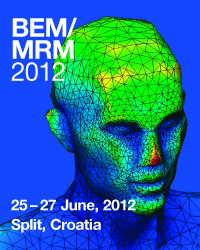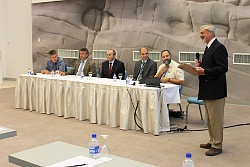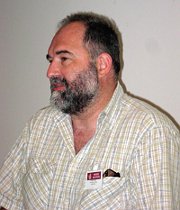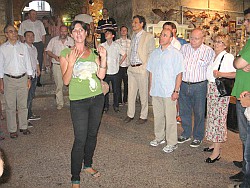BEM/MRM 2012
34th International Conference on Boundary Elements and other Mesh Reduction Methods
25 - 27 June 2012
Split, Croatia
Overview and Opening Address

The 34th International Conference on Boundary Elements and other Mesh Reduction Methods has taken place in Split, Croatia, organised by the Wessex Institute of Technology, represented by Professor Carlos A Brebbia, and the University of Split, represented by Professor Dragan Poljak.
The first conference took place in Southampton, UK in 1978 and since then the meeting has been held annually, demonstrating the strength and continuous evolution of the research on boundary elements carried out by different groups around the world. The large number of volumes produced since 1978 contain papers on practically all major innovations in boundary elements and other mesh reduction methods. The papers presented at the conferences since 1993 are archived in the WIT elibrary (http://library.witpress.com/) where they are permanently available to the international scientific community.
The conference was opened by Carlos who explained the new developments taking place at WIT Campus in the New Forest National Park. Carlos stated the importance of researching boundary element methods in a way that they lead to industrial applications, as part of the process of knowledge dissemination, a major function of WIT. WIT achieves this in a variety of ways, including collaboration with industry and the organisation of courses and conferences all around the world, with the cooperation of major institutions, such as the University of Split. WIT Press, the publishing arm of the Institute, distributes conference books, monographs and edited work in digital and hard cover format, aiming to reach the widest possible coverage. WIT Press aim to increase the number of books year to year as a service to the international community. WIT Press also launched a series of Journals covering a variety of interdisciplinary fields, neglected by other commercial publishers.
Dragan welcomed the delegates to Croatia, following Carlos’ remarks, explaining how the idea of holding the conference in Split started. He also referred to the busy social programme which includes visits to Split and the conference banquet as well as a reception and a guided tour of the renowned Diocletian Palace, Split, the Croatian Coast and the numerous islands offer plenty of opportunities for visits after the conference.
Special Session

Prof Carlos A Brebbia opened the proceedings by pointing out the important results being obtained from the existing link between the University of Split and his Wessex Institute of Technology. The link between the two institutions started 15 or so years ago and began with a number of joint conferences, on a range of topics related to advances in computational methods. This collaboration resulted in three meetings held in Split in 2012, (ie Boundary Element and other Mesh Reduction Methods; Advances in Fluid Mechanics and Heat Transfer). Previous meetings took place in the Split region, including a conference on the island of Brac. Recently, Carlos pointed out, two important conferences were held at the University Institute in Dubrovnik, another beautiful location in Croatia.
Collaboration between WIT and the University of Split – Carlos said – has provided other outstanding results. The two institutions ran a Master course for a period of five years graduating in the process a substantial number of candidates, who contributed a series of outstanding final dissertations. Several of them continued their studies and have now obtained a PhD degree from the University of Wales, the validating authority of WIT.
Many papers in learned journals bear witness to the fruitful links between the two Institutions, and are the result of research collaboration. In addition, WIT Press, the publishing arm of the Wessex Institute, has published several books authored by Split researchers, including some major works by Dragan Poljak on the topic of electromagnetism, EM radiation problems and their effects on human health.
Carlos hoped that his Institute will be able to continue to strengthen its working relationship with the University of Split as well as Croatian industry and other government organisations in the region.
WIT is for instance planning some joint initiatives with the Croatian Hydrodynamics Institute, including a conference on Island Sustainability (see http://www.wessex.ac.uk/12-conferences/islands-2012.html).
Carlos ended his address by thanking the University and the City of Split as well as the county for the warm hospitality that delegates from all over the world have received in this unique part of the Mediterranean.

The philosophy of the School – Dragan said – is towards commercialisation, innovation and interacting with other institutions.
The next speaker was Professor Srojan Podrug, Dean of the Faculty of Engineering at the University of Split, who described in detail the different areas of interest in their Faculty and the research being carried out. This was followed by the welcoming address of Professor Tomisav Kilic, Vice Rector of the University, who referred to the considerable growth that the Institution underwent in the last few years.
Mr Vikko Havidič, Vice Governor of the county of Split, Dalmatia, mentioned the expansion plans to take place in the near future and their targets for technological development; a topic that was also included in the following address by Mr Ivan Vestič, Senior Councillor for the City of Split.
Book Launch

Carlos described first the scientific career of Bengt who completed his education at the renowned Chalmers University of Technology in Göteburg (MSc in Mechanical Engineering 1973, PhD in 1979 and Free Docent in 1980).
Since then he worked at Lund University, where he became a Full Professor of Heat Transfer in 1993. He is currently Head of the Department of Engineering Sciences.
His research contributions span a large number of topics as testified by the Development in Heat Transfer book series that he has been editing for WIT Press since 1995.
He is or has been editor of renowned journals and received several medals and awards, including the ASME Heat Transfer Memorial Award, and the Wessex Institute of Technology Eminent Scientist Medal.
The new book represents his achievements as a teacher and will be a most valuable learning tool for many emerging generations.
Conference Topics
The conference included a series of papers grouped together in the following topics:
- Advanced meshless and mesh reduction methods
- Advanced formulations
- Fluid flow
- Acoustics
- Electrical engineering and electromagnetics
- Emerging applications
Invited Presentations

‘Modeling strain localisation in a segmented bar by a C2 - continuous two-node integrated-RBF element formulation’
by T Tran-Cong, University of Southern Queensland, Australia
‘Meshless implementations of Local Integral Equations for bending of thin plates’
by V Sladek, Slovak Academy of Sciences, Slovakia
‘Meshless solution of 2D and 3D stokes flow using the radial basis integral equation method’
by E-H Ooi, Wessex Institute of Technology, UK
‘On the use of isoparametric elements for BEM modeling of arbitrarily shaped thin wires in electromagnetic compatibility applications’
by D Poljak, University of Split, Croatia
‘A study on topology optimization using levels-set function and BEM’
by T Matsumoto, Nagoya University, Japan
‘A least square solution applied to plate analyses using the traction boundary integral equation’
by L Palermo, University of Campinas, Brazil
‘A boundary element approach to buckling of general laminates’
by S Syngellakis, Wessex Institute of Technology, UK
‘Simulation of ferrofluids by BEM’
by L Skerget, University of Maribor, Slovenia
‘Local regular dual reciprocity method for 2D convection-diffusion equation’
by H Power, University of Nottingham, UK
‘Sound pressure attenuation provided by a 3D rigid acoustic barrier on a building facade: the influence of its longitudinal shape’
by A Tadeu, University of Coimbra, Portugal
‘Residual-free bubble shape functions used in BEM for stability of solution of convective-diffusion transport equation’
by J Ravnik, University of Maribor, Slovenia
EABE Editorial Board Meeting

Tour and Conference Dinner

There was first a guided tour of the surrounding areas of the city, describing some of the most prominent sites, its archaeological and historical past and the beautiful parks, beaches, promenades all along the coast. After this they were shown the most important sites within the Diocletian Emperor’s Palace, whose massive structure is largely intact and gives shelter to a whole range of shops, restaurants, apartments and even churches, the most spectacular of which is the Saint Dominic basilique built upon the foundations of the Emperor’s tomb. In this manner Christianity, a religion that Diocles persecuted, was to triumph over the pagan Emperor. At the end of the tour the delegates were offered a reception in the vaults of the Palace after a recital given by a Choir singing Dalmatian pieces. The reception consisted of typical Croatian dishes and delicacies accompanied by excellent local wines. The event helped to cement even further the links between all participants.
The Conference dinner took place in what is considered the best restaurant in town and the dishes consisted of an excellent starter, a nicely-cooked risotto, followed by a beef cut as main course. This was accompanied by excellent local wines. The evening was enhanced by a quintet that played international songs as well as a few Dalmatian pieces. The relaxed atmosphere and good company helped to cement the links between participants. The restaurant located on the sea front offered outstanding views of the sea and some of the islands facing Split.
Closing of the Conference
The conference was closed by Carlos who thanked all participants for their contributions and hoped that they will be able to participate in the next meeting to be held in the New Forest, UK from 11-13 June, 2013.
Conference Proceedings
The proceedings of BEM/MRM, 364pp (Print ISBN:978-1-84564-622-6, eISBN 978-1-84564-623-3) are available from WIT Press. Orders can be placed on the WIT Press web site at www.witpress.com or by email:
Papers from the conference will also be hosted online at the WIT eLibrary as Volume 53 of WIT Transactions on Engineering Sciences (ISSN: 1746-4471, Digital ISSN: 1743-3533). For more details visit the WIT eLibrary at http://library.witpress.com

 Wessex Institute
Wessex Institute